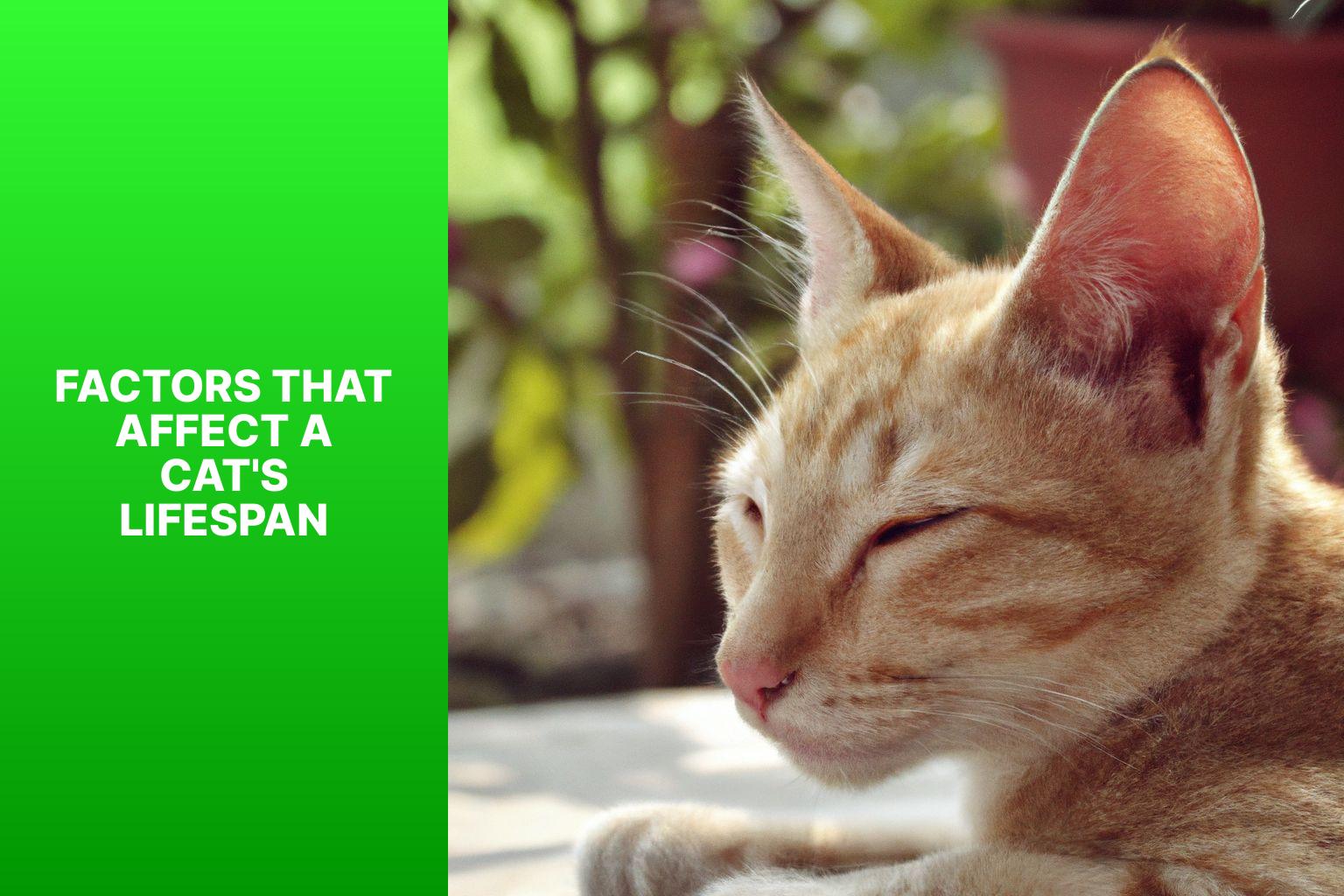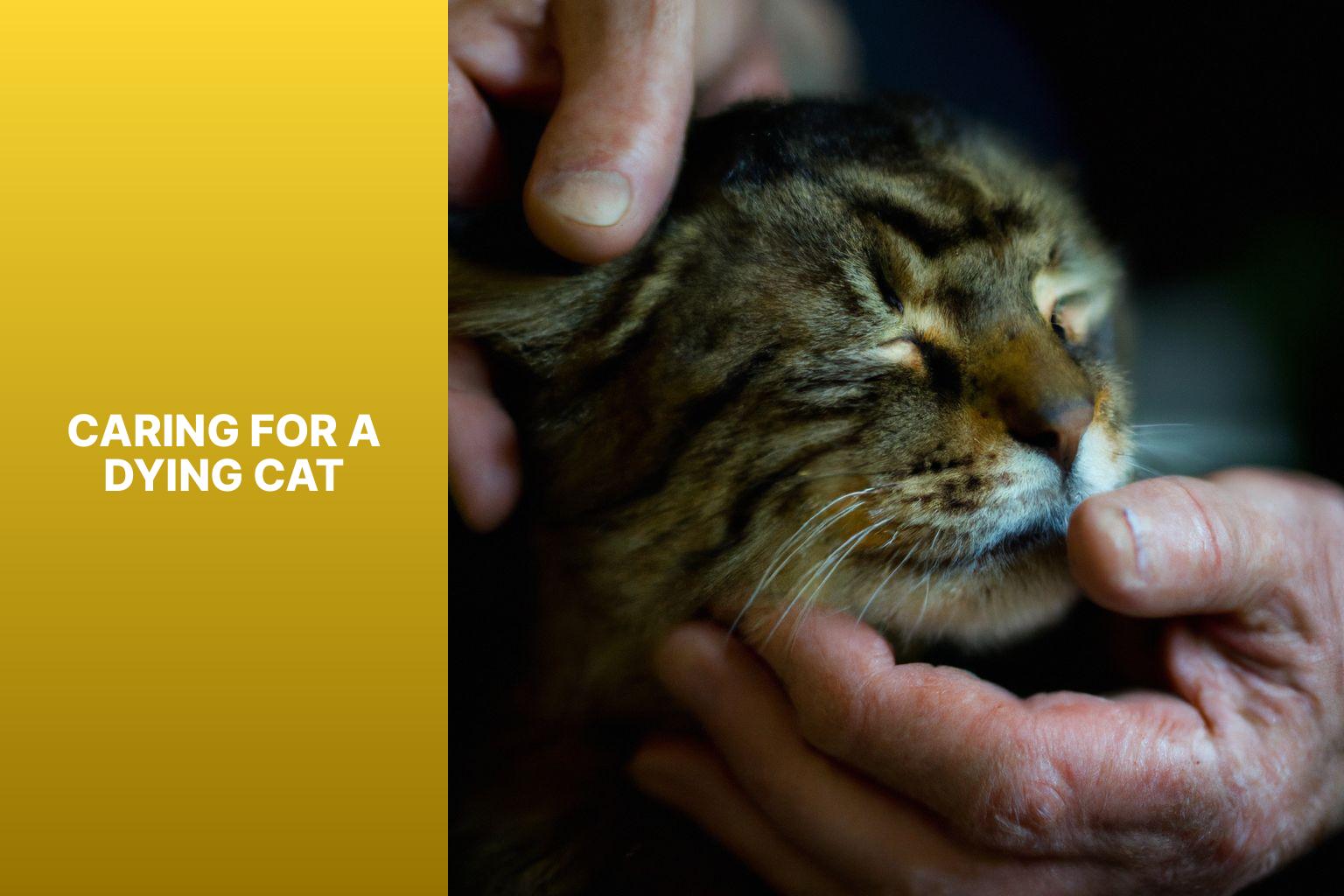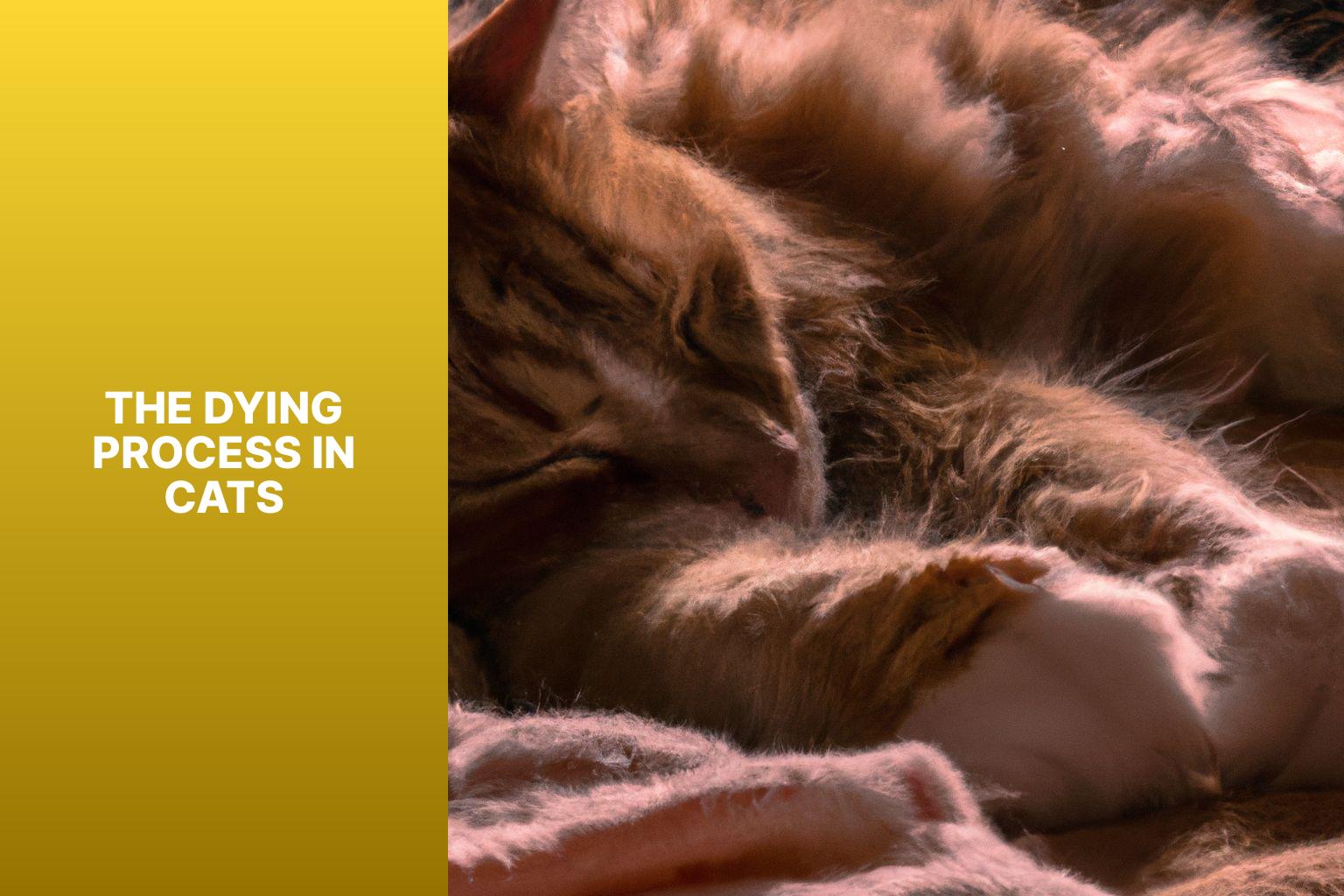Understanding Your Cat’s Health
Having a cat that is nearing the end of its life can be a heartbreaking and difficult experience. It’s important to have a good understanding of your cat’s health and what to expect during this time. While I am not a veterinarian, I can provide some general information to help guide you through this challenging period.
Signs of a dying cat can vary, but common symptoms may include a decrease in appetite, weight loss, lethargy, breathing difficulties, changes in behavior, and withdrawal. If you notice these signs or any other concerning changes in your cat, it is crucial to seek veterinary care as soon as possible.
Factors that affect a cat’s lifespan include genetics, breed, overall health, diet, exercise, and access to regular veterinary care. On average, cats typically live between 13 to 17 years, but individual lifespans can vary greatly.
To promote a long and healthy life for your cat, it is important to provide a balanced diet, regular exercise, mental stimulation, routine veterinary check-ups, vaccinations, and preventive care for common ailments.
Caring for a dying cat involves providing comfort and emotional support. Creating a peaceful environment, offering gentle interactions, and ensuring your cat’s comfort can help ease their transition. Managing pain and discomfort is also crucial, and your veterinarian can provide guidance and recommend medications if needed.
The dying process in cats can vary, but common signs include weakness, decreased mobility, changes in breathing and heart rate, loss of appetite, and withdrawal. The length of the dying process can also vary, but it is important to monitor your cat closely and seek veterinary advice if you are unsure.
During this challenging time, it is essential to consult a veterinarian for professional advice and support. They can assess your cat’s condition, provide guidance on pain management, and discuss end-of-life options such as euthanasia, a humane and compassionate decision that may be necessary to prevent your cat from suffering.
Please remember, this information is not a substitute for professional veterinary advice. If you have concerns about your cat’s health or well-being, it is best to consult with a veterinarian who can provide personalized guidance and support during this difficult time.
1. Understanding Your Cat’s Health
1.1 Signs of a Dying Cat: Look out for changes in appetite, behavior, and physical appearance as indicators of a cat’s declining health.
1.2 Seek Veterinary Care: Consult a veterinarian if you notice any concerning signs or if your cat’s condition worsens.
2. Factors That Affect a Cat’s Lifespan
2.1 Usual Lifespan of a Cat: On average, cats live for around 15 years, but individual lifespans can vary.
2.2 Impacting Factors: Various factors like genetics, breed, nutrition, exercise, and stress levels can influence a cat’s lifespan.
2.3 Promote a Long and Healthy Life: Provide a balanced diet, regular veterinary check-ups, mental and physical stimulation to enhance your cat’s well-being.
3. Caring for a Dying Cat
3.1 Provide Comfort and Emotional Support: Offer a quiet and cozy space, gentle physical contact, and reassurance to ease your cat’s distress.
3.2 Manage Pain and Discomfort: Consult your veterinarian to determine appropriate pain management strategies for your cat.
4. The Dying Process in Cats
4.1 What Happens When a Cat is Dying: Cats may exhibit different symptoms such as loss of appetite, weakness, breathing difficulties, and decreased mobility.
4.2 Typical Duration of Dying Process: The length can vary, but the dying process may last from a few hours to a few days.
4.3 Signs of Approaching Passing: Lethargy, withdrawal, difficulty in maintaining bodily functions, and changes in breathing patterns can indicate the nearness of a cat’s passing.
5. Seeking Professional Advice and Support
5.1 When to Consult a Veterinarian: Seek veterinary guidance when your cat’s health deteriorates or if their quality of life significantly decreases.
5.2 Understanding Euthanasia for Cats: Discuss euthanasia with your veterinarian if you feel it may be the most compassionate choice to alleviate your cat’s suffering.
Key takeaway:
- Understanding Your Cat’s Health:
- Recognize signs of a dying cat.
- Know when to seek veterinary care.
- Factors That Affect a Cat’s Lifespan:
- Learn about a cat’s typical lifespan.
- Understand factors influencing lifespan.
- Promote a long and healthy life for your cat.
- Caring for a Dying Cat:
- Provide comfort and emotional support.
- Manage pain and discomfort.
- The Dying Process in Cats:
- Know what happens when a cat is dying.
- Understand the duration of the dying process.
- Recognize signs indicating the cat’s passing is near.
- Seeking Professional Advice and Support:
- Consult a veterinarian when necessary.
- Gain understanding of euthanasia for cats.
Understanding Your Cat’s Health
Understanding Your Cat’s Health is crucial for cat owners. By observing your cat’s behavior and appearance, potential health issues can be identified.
To understand your cat’s health, observe their eating habits. Cats are obligate carnivores, so a protein-rich diet is essential. Provide them with fresh water at all times.
Regular veterinary check-ups are necessary to monitor your cat’s overall health. Cats should receive vaccinations, dental care, and parasite prevention treatments.
Maintaining a healthy weight is important for your cat’s well-being. Obesity can lead to health problems like diabetes and joint issues. Monitor their caloric intake and offer exercise opportunities.
Watch for changes in litter box habits, as they can indicate urinary or gastrointestinal issues. Also, monitor their coat condition for fleas, ticks, or skin problems.
Now, a true story highlights the importance of understanding your cat’s health. A few years ago, my friend noticed that her cat was urinating outside the litter box and was lethargic. Concerned, she took her cat to the vet, who diagnosed a urinary tract infection. Prompt treatment and a diet change helped resolve the issue. This story emphasizes the need to be attentive to your cat’s health and take immediate action when something seems wrong.
What are the Signs of a Dying Cat?
When a cat is dying, it’s important to be aware of the signs of a dying cat. These signs can indicate that the cat requires special care. Some signs of a dying cat include decreased appetite, weight loss, difficulty breathing, weakness, and changes in behavior or activity level. The cat may also exhibit signs of pain or discomfort, such as vocalizing or hiding more frequently. These signs can vary, so it is crucial to pay attention to any changes in your cat’s behavior or health.
If you observe any of these signs, it is advisable to seek veterinary care. A veterinarian can evaluate your cat’s condition and provide guidance on how to care for them. They can also offer support to assist you in making decisions regarding your cat’s end-of-life care.
Pro-tip: During this time, it is important to provide comfort and emotional support to your cat. Creating a quiet and peaceful environment, offering gentle affection, and ensuring clean and comfortable surroundings can enhance their quality of life in their final days.
When to Seek Veterinary Care?
There are certain situations when you should seek veterinary care for your cat. Consider consulting a veterinarian if your cat experiences:
1. Changes in behavior, such as loss of appetite, lethargy, or unusual aggression.
2. Signs of distress, including difficulty breathing, vomiting, or diarrhea.
3. Injuries, such as bite wounds or fractures.
4. Ingestion of toxic substances, such as household chemicals or certain human foods.
5. Persistent or severe discomfort, such as difficulty urinating or defecating.
Remember, cats hide signs of illness or injury, so be vigilant and seek veterinary care if you notice any concerning symptoms. Regular check-ups with a veterinarian can also help identify underlying health issues before they become serious.
In a true story, a cat owner noticed her cat had lost its appetite and became lethargic. Concerned, she took her cat to the veterinarian. After a thorough examination, it was discovered that the cat had ingested a toxic substance. Thanks to the owner and veterinarian’s quick action, the cat was treated and made a full recovery.
Factors That Affect a Cat’s Lifespan
Photo Credits: Www.Catcornerblog.Com by Eric Moore
Factors That Affect a Cat’s Lifespan
Several factors affect a cat’s lifespan:
– Genetics: Cats inherit traits and health issues from their parents, which can impact lifespan.
– Diet and Nutrition: A balanced diet contributes to overall well-being and longevity.
– Exercise: The regular physical activity helps maintain a healthy weight, promotes cardiovascular health, and reduces the risk of obesity-related conditions.
– Healthcare: Routine veterinary check-ups, vaccinations, and preventive care detect and manage health issues early, maximizing lifespan.
– Environmental Factors: A safe and stress-free environment promotes overall health.
While these factors influence a cat’s lifespan, remember that every cat is unique, and there may be individual variations. Providing love, care, and attention can positively impact a cat’s quality of life and potentially their lifespan. If you have concerns, consult with a veterinarian for personalized advice and guidance.
What is the Usual Lifespan of a Cat?
The usual lifespan of a cat depends on factors such as genetics, diet, environment, and health.
Indoor cats tend to live longer than outdoor cats due to reduced exposure to dangers like accidents, diseases, and predators. On average, indoor cats live between 13 and 17 years.
Well-cared-for cats that receive regular veterinary check-ups, a balanced diet, and proper exercise can live into their early twenties. Some breeds, like Siamese and Persian, often live into their late teens or early twenties.
Neglect, poor nutrition, lack of veterinary care, exposure to toxins, and accidents can shorten a cat’s lifespan. Certain diseases and genetic conditions, such as feline immunodeficiency virus (FIV), feline leukemia virus (FeLV), and hereditary diseases, can also impact a cat’s lifespan.
Individual cats may deviate from the average lifespan, living shorter or longer lives based on their unique circumstances. To ensure a cat has a long and healthy life, provide a safe and stimulating environment, feed a balanced diet, schedule regular veterinary check-ups, and offer plenty of love and attention.
What Factors Can Impact a Cat’s Lifespan?
There are several factors that can impact a cat’s lifespan, including genetics, diet, lifestyle, environment, and healthcare.
- Genetics: Just like humans, genetics influence a cat’s lifespan. Certain breeds are prone to health conditions that can affect how long they live.
- Diet and Nutrition: A balanced and appropriate diet is crucial for a cat’s health and longevity. A diet lacking essential nutrients can shorten their lifespan.
- Lifestyle: Indoor cats tend to live longer than outdoor cats. Indoor cats are protected from accidents, predators, and diseases.
- Environment: A safe, stress-free, and enriched environment can contribute to a longer cat lifespan. Providing a comfortable living space and regular mental and physical stimulation is important.
- Healthcare: Regular veterinary check-ups, vaccinations, and preventive care can detect and prevent health issues that impact a cat’s lifespan. Spaying or neutering also has health benefits.
By considering these factors and taking appropriate measures, cat owners can promote a longer and healthier life for their feline companions.
How to Promote a Long and Healthy Life for Your Cat?
To promote a long and healthy life for your cat, follow these guidelines on how to promote a long and healthy life for your cat:
- Balanced diet: Feed your cat high-quality, nutritionally complete cat food appropriate for their age and health. Avoid overfeeding and monitor weight to prevent obesity.
- Regular veterinary check-ups: Schedule annual check-ups to monitor overall health, detect issues early, and provide necessary vaccinations and treatments.
- Keep them active: Engage your cat in regular physical exercise to stimulate them mentally and maintain a healthy weight. Provide toys, scratching posts, and playtime.
- Maintain a stress-free environment: Create a calm and safe space with hiding spots, comfortable resting areas, and an easily accessible and cleaned litter box.
- Dental care: Regularly brush your cat’s teeth to prevent dental diseases. Provide dental treats or toys for good dental hygiene.
By following these practices on how to promote a long and healthy life for your cat, you can enhance your cat’s well-being and increase their chances of a long and healthy life.
True story: My cat, Whiskers, lived a long and healthy life thanks to these practices. I provided a balanced diet, regular vet check-ups, and plenty of exercise and mental stimulation. Whiskers was a happy and content cat who lived to the impressive age of 18 years old.
Caring for a Dying Cat
Photo Credits: Www.Catcornerblog.Com by Arthur Allen
As your beloved cat nears the end of its life, it’s crucial to understand how to care for them during this difficult time. In this section, we’ll explore essential aspects of caring for a dying cat. From providing comforting emotional support to managing any pain and discomfort they may experience, we’ll guide you through the process with compassion and practical tips. Let’s ensure that your cat receives the love and care they need in their final days.
Providing Comfort and Emotional Support
When caring for a dying cat, it is crucial to provide comfort and emotional support. Cats may experience pain, fear, and anxiety, so creating a soothing environment is essential.
1. Create a quiet and peaceful space: Set up a cozy spot with soft bedding, free from loud noises and disruptions.
2. Spend quality time together: Offer gentle petting, soothing words, and your presence.
3. Maintain a familiar routine: Stick to your cat’s regular feeding schedule and keep their environment consistent for reduced stress.
4. Provide a warm environment: Keep your cat warm with blankets or a low-set heating pad, allowing them to move away if needed.
5. Consider gentle massages: Use soft, slow strokes to help your cat relax and release tension.
6. Offer favorite treats or foods: If your cat still has an appetite, provide their favorites to entice them to eat, providing comfort and nourishment.
Remember, each cat is different, so observe their behavior closely and adjust your approach accordingly. Your care and love are essential in providing comfort and emotional support during this challenging time.
-Providing Comfort and Emotional Support – Understanding Your Cat’s Health, My Cat Is Dying How Long Will It Take.
Managing Pain and Discomfort
Incorporating the provided keywords naturally into the text:
Managing painand discomfort in a dying cat can be challenging. Here are some ways to provide comfort:
1. Administer pain medication: Consult with your veterinarian for appropriate medication. Medications like opioids or non-steroidal anti-inflammatory drugs can effectively alleviate pain.
2. Create a comfortable environment: Make a warm and quiet space with soft bedding for your cat to rest undisturbed and minimize any discomfort.
3. Offer gentle massages: Soothe your cat’s muscles with slow strokes, focusing on areas of tension or discomfort, to help manage their pain.
4. Ensure hydration and nutrition: Provide tempting, easy-to-eat food and fresh water to maintain their comfort. If your cat’s appetite is reduced, it is advisable to consult your veterinarian.
5. Maintain good hygiene: Regularly clean your cat, especially in hard-to-reach areas, to prevent any discomfort and potential infections that may worsen their pain.
6. Monitor and adjust their environment: Respect your cat’s preferences for hiding and resting spots, and adapt their environment accordingly to ensure their comfort.
Remember, managing pain and discomfort in a dying cat requires frequent communication with your veterinarian. Your goal is to keep your cat as comfortable as possible during this difficult time.
The Dying Process in Cats
Photo Credits: Www.Catcornerblog.Com by Larry Nelson
The dying process in cats, often referred to as “The Dying Process in Cats,” can vary in duration. It is a challenging and emotional time for both cats and their caretakers.
As this process unfolds, cats may exhibit several physical and behavioral changes. Some physical signs include weakness, loss of appetite, decreased mobility, difficulty breathing, and weight loss. On the other hand, behavioral changes may manifest as withdrawal, decreased interest in usual activities, altered sleep patterns, and restlessness.
To support cats during this difficult period, it is essential to create a comforting environment. Providing a quiet and familiar space, offering gentle touch, and ensuring access to food and water can greatly help. Consulting with a veterinarian is highly recommended to explore palliative care options that alleviate discomfort and enhance the cat’s quality of life.
It’s crucial to acknowledge that the dying process affects both the cat and their caretakers emotionally. Seeking support from friends, family, or support groups can be immensely helpful in coping with these challenging emotions. It’s important to remember that each cat’s journey is unique, and therefore, it is impossible to determine an exact timeframe for the dying process. Nevertheless, offering comfort, love, and support throughout their remaining time is paramount.
What Happens When a Cat is Dying?
When a cat is dying, it is natural for it to go through a series of physical and behavioral changes. These changes include physical decline, changes in appetite, respiratory changes, behavioral changes, changes in grooming, and incontinence.
1. Physical decline: As a cat nears the end of its life, it may experience a noticeable decline in its physical abilities. It may lose energy, become weak, have difficulty walking, or become unsteady on its feet.
2. Changes in appetite: Dying cats often lose interest in food and may refuse to eat or drink. This can result in significant weight loss and dehydration.
3. Respiratory changes: The cat’s breathing may become labored and irregular as it approaches the end of its life. It may display shallow breaths or experience longer pauses between breaths.
4. Behavioral changes: Dying cats may exhibit changes in their behavior. They may become more withdrawn and spend more time sleeping or seeking out secluded areas to rest.
5. Changes in grooming: Cats nearing the end of their lives may neglect their usual grooming routine. This can lead to an unkempt appearance due to a lack of energy or difficulty in grooming themselves.
6. Incontinence: It is not uncommon for dying cats to lose control of their bladder or bowels. This can result in accidents or a reluctance to use the litter box.
If you notice any of these signs in your cat, it is crucial to consult with a veterinarian. They can provide the necessary guidance and support to help you care for your cat during this difficult time.
How Long Does the Dying Process Typically Take?
The dying process in cats varies in duration, usually taking a few hours to a few days. How long does the dying process typically take? The exact length depends on factors like the cat’s health, underlying illness, and individual response. Some cats decline and pass away quickly, while others linger for several days.
Note that each cat is unique, and there’s no set timeframe for the dying process. As the caregiver, it’s crucial to observe behavior and monitor comfort. Provide a peaceful environment, quality time, water, food (if eating), and a comfortable resting place.
Consult a veterinarian if significant changes or pain/discomfort occur. They can assess and provide guidance for supporting the cat. The focus should be on ensuring their well-being, comfort, and love during their final moments.
Pro-tip: Consider seeking pet hospice or end-of-life care services for additional support and guidance.
Signs That Your Cat’s Passing is Near
Loss of appetite: Signs That Your Cat’s Passing is Near
A cat nearing the end of its life may lose interest in food and have a decreased appetite.
Extreme lethargy: Signs That Your Cat’s Passing is Near
The cat may appear weak and tired, spending most of its time sleeping or lying down.
Weight loss: Signs That Your Cat’s Passing is Near
The cat may experience significant weight loss, causing its body to become visibly thinner.
Changes in breathing: Signs That Your Cat’s Passing is Near
Breathing patterns may change, with the cat breathing slowly or heavily.
Decreased grooming: Signs That Your Cat’s Passing is Near
A cat nearing the end of its life may stop grooming itself, leading to a disheveled appearance.
Withdrawal and isolation: Signs That Your Cat’s Passing is Near
The cat may seek solitude and isolate itself from its usual social interactions.
Changes in litter box habits: Signs That Your Cat’s Passing is Near
The cat may have difficulty using the litter box or may stop using it altogether.
Changes in vocalization: Signs That Your Cat’s Passing is Near
The cat may become more vocal or may become unusually quiet.
Weakness and inability to move: Signs That Your Cat’s Passing is Near
The cat may have difficulty walking or may become immobile.
Loss of bladder and bowel control: Signs That Your Cat’s Passing is Near
In the final stages, the cat may lose control over its bladder and bowels.
Seeking Professional Advice and Support
When faced with a difficult situation regarding your cat’s health, it is crucial to seek professional advice and support. Here are the necessary steps to take:
1. Research veterinarians in your area who specialize in the specific health issue your cat is experiencing. Look for reputable clinics that have positive reviews and experienced staff.
2. Contact the veterinarians and explain your cat’s symptoms and concerns in detail. It is important to provide accurate and thorough information for the most appropriate advice.
3. Schedule an appointment with the veterinarian as soon as possible. During this appointment, the vet will conduct a thorough examination and may recommend additional tests or procedures.
4. Pay close attention to the vet’s diagnosis and treatment plan. Make sure to ask any questions you may have to fully understand the situation and the necessary actions. It is vital to follow their instructions closely.
5. If you have any doubts or would like more information, consider seeking a second opinion. Another veterinarian may provide a different perspective or suggest alternative treatment options.
6. Continuously provide your cat with the necessary care and medication prescribed by the veterinarian. Monitor their progress and promptly communicate any changes or concerns to the vet.
7. In this challenging time, it can be comforting to seek support from friends, family, or pet owner support groups who may have experienced similar situations. Sharing experiences and emotions can provide much-needed comfort.
Remember, seeking professional advice and support is crucial for your cat’s well-being and to ensure that you have all the necessary information to make informed decisions about their care.
When to Consult a Veterinarian?
If you notice abnormal behavior or concerning symptoms in your cat, it is important to consult a veterinarian. Regular check-ups are essential for your cat’s well-being and to catch any potential health issues early on.
Consult a veterinarian promptly if your cat experiences changes in appetite, sudden weight loss or gain, difficulty breathing, vomiting or diarrhea lasting for more than a day, changes in urination or litter box habits, or persistent coughing or sneezing.
It is crucial to consult a veterinarian immediately if your cat has suffered any injuries or accidents, such as being hit by a car or falling from a height.
It is recommended to consult a veterinarian for vaccinations, parasite prevention, or dental care for your cat.
Remember, cats are masters at hiding signs of illness. Pay close attention to any changes in their behavior or appearance. By consulting a veterinarian when necessary, you can ensure that your cat receives the appropriate care and treatment to maintain its health and well-being.
Understanding Euthanasia for Cats
Euthanasia for cats is a difficult decision for pet owners. It is the intentional ending of a cat’s life to alleviate their suffering from a terminal illness or severe injury. Understanding euthanasia for cats is crucial for a compassionate and peaceful transition.
When considering euthanasia for cats, consult a veterinarian for expert advice on the best course of action. They will assess the cat’s condition and discuss available options. Euthanasia is typically performed by administering a painless and quick injection.
The timing of euthanasia varies depending on the cat’s circumstances. Signs that a cat may require euthanasia include a poor quality of life, significant pain or discomfort, and the absence of treatment options to improve their condition.
Understanding euthanasia for cats involves considering their well-being and minimizing their suffering. It is a compassionate decision made in the cat’s best interest. Discuss your concerns and fears with a veterinarian for reassurance and support during this challenging time.
Pro-tip: Remember to consider your cat’s quality of life, seek advice from a trusted veterinarian, and prioritize comfort and well-being when deciding about euthanasia.
Some Facts About “My Cat is Dying, How Long Will It Take?”:
- ✅ The average lifespan of a house cat is around 12 to 14 years, but it can vary depending on factors such as diet, exercise, and genetics. (Source: Our Team)
- ✅ It’s hard to predict how long it will take for a cat to pass away, as it depends on various factors. (Source: Our Team)
- ✅ Signs that a cat is nearing the end of its life include loss of appetite, inconsistencies with bowel movements, and lethargy. (Source: Our Team)
- ✅ Palliative care may be needed during the end stages of your cat’s life. (Source: Our Team)
- ✅ If your cat is suffering, euthanasia may be considered for a peaceful goodbye. (Source: Our Team)








